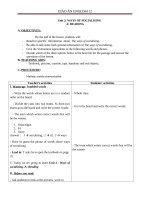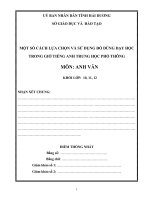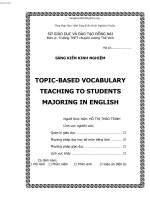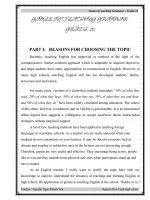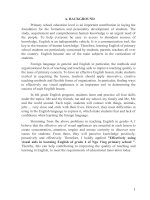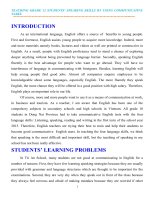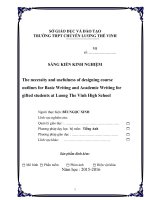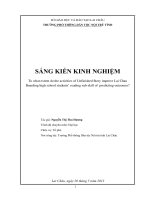skkn tiếng anh 12 APPLICATION OF TEACHING COMPARISON STRUCTURES INTO COMMUNICATIVE METHOD
Bạn đang xem bản rút gọn của tài liệu. Xem và tải ngay bản đầy đủ của tài liệu tại đây (256.35 KB, 39 trang )
Experience initiative: Application of teaching comparison structures into communicative method-Quách Đại Châu
APPLICATION OF TEACHING COMPARISON STRUCTURES
INTO COMMUNICATIVE METHOD
I. THE BACKGROUND OF THE STUDY
As a teacher of English, through many years of teaching at Dieu Cai High
School, I see that many students have many difficulties in speaking English,
including students in grade 12. In general, even most of the first-class students they
are just good at grammar. This puts questions and solutions to me.
By finding and studying in documents, combining personal experience and
teaching experience from my accompanies, I decided to choose the study named:
Application of teaching comparison structures into communicative method.
First, I chose it for the purpose, that is, it has a high level of practical
application. A learner not only learns English for his exam - or for any demands
his company forces him, besides he learns it for communication, to communicate
with foreigners. Communication plays an important part in society of human
beings. Every day people have to use their language to communicate, to get and
exchange information, thoughts, feelings…For short, there would not be any
society of human beings if communication activity did not happen.
Second, another reason is because of the objective demands of education
development at present. It is now that teaching and learning activities are
appreciated mainly by how much knowledge students get from the lectures,
students play the most important part in learning. It is also easy to apply this
method and it makes my lecture more active and successful.
Finally, the main reason is that this method is quite interesting and I consider it
as a new method because it has never been applied in my school. The students in
my classes were almost interested in it and so was I. The atmosphere of the class
was more rousing, the class had more volunteers, laughter and Vietnamese was
spoken fewer. Actually and fortunately I couldn’t use this method frequently
because time for each period is limited. The thing that teacher forced to teach
closely according to the content of the textbook is also a limit to me sometimes.
Above those are the reasons as well as the impulses made me write this study.
II. PRACTICAL AND THEORETIC BASIS
1. THEORETIC BASIS
Some of my lesson plans were applied from some methods of the writer
Suzanne W.Woodward. I redesigned some to be suitable for contents and
exercises in English textbooks of grade 10. They mainly include the application
of communicative method. Therefore, it is necessary to know what the
communicative method is. The communicative method emphasizes on the
communicative ability of semantics of the message instead of focusing only on
the grammatical and phonetic perfection. That is appreciated in ability and
1
Experience initiative: Application of teaching comparison structures into communicative method-Quách Đại Châu
capacity for what learner has learned from the lessons as well as the knowledge
on foreign language.
We all know that the new thing is often derived from the old one. Teaching
English with the method above is similar. This method is developed owing to the
traditional method. Even though teaching methods are defined in many ways, in
my opinion, there are three main methods:
1.1. Traditional teaching method:
For this method students listen and write all things which a teacher conveys,
try to remember or learn things by heart and then they have to retell the old
lessons by “checking old lessons” of the teacher. This means that teacher plays a
main part during learning and teaching activity. It gives students knowledge
about grammar but it is difficult for them to speak English then.
1.2.
Purely communicative method:
This is the method aiming to limit students to speak their native language.
Through pictures, gestures…, students may understand the content of the lesson
they are learning and know ways to carry out activities to penetrate it. This method
is used almost by automatic reflect, more suitable for children, so the logic of the
content is needed, if not the learning will be interrupted.
1.3. Combination of the methods (Combination between purely
communicative method and traditional method).
This is also the method creating the name of this study. This method is for
students in low-level class, as it is not able to apply the purely communicative
method or the traditional method. It is formed by the combination of the two
methods to consolidate and develop students’ continuing learning ability.
Therefore, I see it is the most appropriate method to apply for all kinds of student,
especially for the students in low- level class. Students not only acquire knowledge
in traditional ways but also develop speaking ability fluently and creatively, from
the introduction of the teacher and teaching aids. Sometimes, lively and practical
theories should be taught before practicing.
I used this method (combination of the methods) to teach my students and I see
it quite better than the application of traditional methods. However; in some cases,
if the purely communicative method may not be quite applied, I think the
combination of the methods is the most suitable.
2. PRACTICAL BASIS
Since old days in many branches, people have used English for communication.
There were many people unsuccessful in learning English beside those who were
successful. They spent a lot of time and money learning English but they failed.
What were the reasons? There were many different causes. In my opinion, I think
these were mainly because of our ways of teaching and learning. Some of our
teaching and learning methods were still too old and traditional.
2
Experience initiative: Application of teaching comparison structures into communicative method-Quách Đại Châu
So far, teaching for speaking English at general schools has not been applied
regularly. Traditional ways have still used too much, which some have been out of
date. Only has Grammar almost taught for getting high marks in examinations.
Students did not have many chances to talk English to others. These were the
reasons why students could not develop their speaking. Also, it was easy for
students to forget what they had just learned.
Nowadays, the demands for learning English are higher and higher. In my
school many students haven’t spoken English fluently yet. They have a lot of
difficulties in speaking English while, in near future, students have to get a
standard of English skills after graduating from high school, including mainly
communicative skills. It is a difficult problem for us and not easy to fulfill in a
short time.
In diplomatic relations, using foreign language to communicate also plays a
very important part. That is the communication among people, groups of people,
nations... Every day there are thousands of transactions, business, branches,
organizations and companies in the world using English for communication.
Communication is considered as a bridge to connect people, nations, friendship,
development, co-operation, peace…. Using of English for communication may be
understood in many different ways. Learning English is not only for examination
but also for many other purposes such as: teaching, studying, translation, jobs… of
all the purposes, almost learners first they learn English for speaking fluently.
Those who can speak fluently a foreign language, this means that they have
learned English in right ways.
3. PRACTICAL STATES
3.1. Advantages:
The school managing Board always takes care of the development of English
subject and supplies facilities, teaching aids to improve its quality. English
teaching staffs are always interested in teaching career, if someone has any
difficulty in teaching they are ready to show their help.
The teaching Staffs and the Union of the School are ready to support plans of
English Group and cooperate with Group to educate and remind students to learn
English. Along with launching the movement of the English Olympic examination
on the internet, every year the school often organizes the competition named “The
sound of the golden Gong”, including oral tests about English, which creates a very
good field for students to learn English.
3.2. Disadvantages:
As a school located in a rural and mountainous area, it is poor and still lacks of
many things. It is not enough classrooms, labs, facilities… for students, parents are
poor so they may not take care of their children well as they want. Also, many
students are not much aware of learning English, even some have many passive
thoughts of English because of the objective causes. This certainly influences on
their enthusiasm for English. Many are not interested in learning it and many are
3
Experience initiative: Application of teaching comparison structures into communicative method-Quách Đại Châu
afraid of speaking in front of the crowd. They do not also have many chances to
communicate with native speakers who are English.
III. ORGNIZATION AND PRESENTATION OF THE SOLUTIONS
1. PURPOSES:
Some solutions of the study should be flexibly applied in accordance with the
design of the textbook. Knowing the ability of my students, I designed the lesson
properly, according to the demand of the lesson. This study aims for the developing of
some communicative skills for students in general schools, especially for students in
grade 10, who are not good at this skill very much. Ways and stages to teach are the
same, but for students who are not good at English, I do not put in my teaching with
difficult words or sentences. When I want to review any kind of theory, which the
purely communicative method may not be used, I will use the combination of the
methods to teach so that students can understand better my teaching before practicing.
This keeps them unembarrassed, and my teaching is therefore more fluent.
2. SOLUTIONS:
As mentioned above, teacher should choose one of the methods for each time to
teach according to the purpose, the content, or the demand of the lesson, to find out
ways to design properly suitable for students’ ability and knowledge.
Below I am going to present a teaching lesson designed from the textbook,
LANGUAGE FOCUS part (Grammar and vocabulary), page 176, English 10. This
lesson may be divided into two following stages:
Stage 1.
- Provides some examples so that students elicit comparative structures from
them (Review old lesson, because students already learnt them before). At this
stage, the traditional method is mainly used first.
COMPARATIVES AND SUPERLATIVES
1. Comparatives:
Ex 1: I am taller than Mai.
Ex 2: She is more beautiful than her sister.
2. Superlatives:
Ex 3: I am the oldest in my family.
Ex 4: He is the most intelligent boy in the class.
- Give the hints so that students elicit the structures of the comparative from the
examples, underlines the letters which show the form of the comparative, subjects S1,
S2… Similar to the structures elicited from the examples, teacher asks students to
provide more examples.
4
Experience initiative: Application of teaching comparison structures into communicative method-Quách Đại Châu
* Structures:
Comparatives:
S1 + to be + short adjective_er + than + S2 (Ex 1)
S1 + to be + more + long adjective + than + S2 (Ex 2)
Superlatives:
S 1 + to be + the + short adjective_est (Ex 3)
S + to be + the + most + long adjective (Ex 4)
-
Use a small table designed properly, listing 4 special cases (a, b, c, d) by giving
some words to demonstrate.
TABLE
Adjective (Root)
Comparative
Superlative
a)
big
bigger
the biggest
wet
wetter
the wettest
hot
hotter
the hottest
funny
funnier
the funniest
easy
easier
the easiest
happy
happier
the happiest
noble
nobler
the noblest
new
newer
the newest
clever
cleverer
the cleverest
narrow
narrower
the narrowest
good
better
the best
bad
worse
the worse
far
farther/further
the farthest/ the furthest
many (much)
more
the most
little
less
the least
b)
c)
d)
5
Experience initiative: Application of teaching comparison structures into communicative method-Quách Đại Châu
- Ask students to elicit the rule for each case.
* Rules:
a) Double last letter before adding _er or _ est.
b) Two-syllable adjectives ending “_y”, changing “y” into “i” before adding “er”.
c) Two-syllable adjectives ending “_le”, “_ow”, “_er”, adding the letter “er” for its
comparative form and adding the letter “_est” to its superlative form.
d) The irregular case.
Stage 2. Communicative activities are merged into exercises (Exercise 1, English
10). This stage is carried out below:
Exercise 1: Write the comparative and superlative forms of the adjectives.
Adjective
1. cheap
2. expensive
Comparative
Superlative
cheaper
the cheapest
more expensive
the most expensive
3. young
_______________________ ________________________
4. happy
_______________________
_______________________
5. big
_______________________
_______________________
6. busy
_______________________
_______________________
7. intelligent
_______________________
_______________________
8. beautiful
_______________________
_______________________
9. bad
_______________________
_______________________
10.far
_______________________
_______________________
11.new
_______________________
_______________________
12. dangerous
_______________________
_______________________
6
Experience initiative: Application of teaching comparison structures into communicative method-Quách Đại Châu
- Create 2 tables from the original one:
Table 1:
Adjective
1. cheap
2. expensive
Comparative
Superlative
cheaper
the cheapest
more expensive
the most expensive
3. young
_______________________ ________________________
4. happy
_______________________ ________________________
5. big
_______________________ ________________________
6. busy
_______________________
_______________________
7. intelligent
_______________________
_______________________
8. beautiful
_______________________
_______________________
9. bad
_______________________
_______________________
10.far
_______________________
_______________________
11.new
_______________________
_______________________
12.dangerous
_______________________
_______________________
Table 2: The position of the adjectives in the table 1 should be different from that of
the ones in the table 2, to avoid students’ copying.
Adjective
Comparative
Superlative
cheaper
the cheapest
more expensive
the most expensive
_______________________
4. happy
_______________________
_
5. far
_______________________
_______________________
6. expensive
_______________________
_______________________
7. dangerous
_______________________
_______________________
8. cheap
______________________
_______________________
1. young
2. new
3. intelligent
7
_______________________
Experience initiative: Application of teaching comparison structures into communicative method-Quách Đại Châu
9. busy
_______________________
_______________________
10.big
_______________________
_______________________
11.beautiful
_______________________
_______________________
12.bad
_______________________
_______________________
_______________________
- Stick the tables on the blackboard as long as all students can see them clearly.
- Create any puzzle to students or teacher may give them marks by asking some
representatives who have good writing to present before the class.
- Any group who finishes first or having more right answers than others are
winners, and good marks will be given to them, one right answer for one mark.
- Exercise 2: Put the words in the correct order to make sentences or
questions. (English 10, page 176, 177)
1. family/the/am/my/in/I/oldest
I am the oldest in my family.
2. sister/me/my/than/younger/is
__________________________________________________________
3. class/who/oldest/the/the/in/is?
__________________________________________________________
4. passenger/plane/used to be/ Concord/world/fastest/the/in/the
__________________________________________________________
5. book/interesting/than/my/your/more/is/book
__________________________________________________________
6. bought/expensive/shop/the/in/watch/most/Peter/the
__________________________________________________________
7. cheapest/buy/you/shop/in/the/the/did/watch?
__________________________________________________________
8. difficult/German/English/is/than/more/much
__________________________________________________________
9.
weather/better/today/than/much/is/yesterday/the
__________________________________________________________
- Ask students to do the exercise and to present their answers. It is more easy for
them in the next activity when they have some minutes to learn by hearts all
sentences. Teacher may design some other questions and answers.
8
Experience initiative: Application of teaching comparison structures into communicative method-Quách Đại Châu
- Deliver to each one card. Each card contains one question suggested answering
in the exercise in the textbook. The cards are cut from the following handout:
HANDOUT
_______ please! Who is the oldest in your _______ please! Who is younger, your
family?
sister or you?
_______ please! What kind of plane is the _______ please! Which book is more
fastest in the world?
interesting, your book or mine?
_______ please! Who bought the most _______ please! Which is more difficult,
expensive watch in the shop?
English or German?
_______, Minh is the oldest in the class. _______ please! I bought the cheapest
Now, question?
watch in the shop. Now, question?
_______ please! Which the weather is
much better, today or yesterday?
- The number of cards should be equal to the number of students in the class. So
teacher may copy many handouts as possible. A student has to ask question to
another student whose name is already written in the blank in his or her card.
- After each pair finishes their question and answer, teacher may act as a third
person to ask more questions like this example below:
Minh: Nga please! Which book is more interesting, your book or my book?
Nga: My book is more interesting than your book (yours).
Teacher: Nam, whose book is more interesting, Nga’s book or Minh’s book?
Nam: Nga’s book is more interesting than Minh’s book.
Here I am going to list some methods having both grammar and
communication. Depending on purposes, aims, the design of the lesson or students’
knowledge, teacher should decide to review the lesson or reteach it. Sometimes
9
Experience initiative: Application of teaching comparison structures into communicative method-Quách Đại Châu
teacher does not need to teach grammar but students can understand the lesson
clearly.
3. GENERAL SOLUTIONS:
3.1)
TEACHING COMPARATIVES
* COMPARATIVE CARDS
Materials: Small pictures
Dynamic: Pairs
Procedure:
- Reminds the rules for the comparative, if necessary (Presented).
- Arrange students in pairs, and give each pair two or more pictures to compare. (We
may want to stick to one topic, such as famous people, or have several types of
pictures.)
- Each pair writes comparisons of the two pictures. For example, when we want to
teach 4 adjectives small, big, cheap and expensive, first students will have pictures
and then the stages are carried out as follows:
Bicycle/ cheap
Car/ expensive
Cow/ small
Elephant/ big
…
- Provide the structure and then give an example for it:
S1 + to be + short adjective_er + than + S2
Ex: Nam is tall. Nga is short.
10
Experience initiative: Application of teaching comparison structures into communicative method-Quách Đại Châu
→ Nam is taller than Nga
- The representative will show the picture to the class and then say his/her
sentence:
Student: A cow is smaller than an elephant/ An elephant is bigger than a cow.
- Similarly, in order to compare between a car and a bicycle, teacher gives
examples and provides more comparative structures for long adjective.
S1 + to be + more + long adjective + than + S2
Ex: A restaurant is luxury. A stall is poor.
→ A restaurant is more luxury than a stall
- The representative will show the class the car and the bicycle in the picture and
say like this:
Student: A bicycle is cheaper than a car/ A car is more luxury than a
bicycle.
…
- Teacher asks the class to give their comments (agree or disagree) and gives
feedback after that.
* Note: If we choose famous people, we can write the names of the people under
the picture for the students, or have them say simply “the man or the car in picture
A, B…,” etc.
* MATCH
Materials: Worksheet
Dynamic: pairs
Procedure:
- Teacher reminds the rules of the comparative, if necessary.
- Check and explain new words as well as pronunciation.
- Put students into pairs, and give each pair a copy of the worksheet. Go over the
words on the list and explain any with which the students are unfamiliar.
- Call out an adjective or phrase from the list below. The students choose two of
the words or expression on the worksheet and write a comparison sentence.
Continue until all the words on the paper have been matched.
Adjectives to use with the worksheet:
clean
expensive
noisy
slow
cold
good pet
quick
spicy
dangerous
hard
short
tall
11
Experience initiative: Application of teaching comparison structures into communicative method-Quách Đại Châu
easy to use
large
Example:
Teacher: “noisy”
Students write or say: “A city is noisier than a country”
- Go over the sentences by having the pairs write them on the blackboard or read
them aloud. The other students decide if the sentences are logical and
grammatical.
WORKSHEET. MATCH
Your teacher will give you an adjective. Choose two words in this list and write a
sentence using the two words and the adjective.
airplane
cat
dog
ladder
rock
ant
chalk
fog
lake
snow
bee
charge cards
giraffe
Mexican food
stilts
bus
checks
Italian food
mud puddle
wolf
1.
2.
3.
4.
5.
6.
7.
8.
9.
10.
3.2) TEACHING SUPERLATIVES
* CLASSMATE QUESTIONNAIRE
Materials: Worksheet
Dynamic: Pairs
Procedure:
12
Experience initiative: Application of teaching comparison structures into communicative method-Quách Đại Châu
- Put the students in pairs. Give each pair a copy of the handout.
- Have the students answer the question in complete sentences. Some students
will be able to answer without talking to their classmates, but others will require
asking their classmates’ questions.
Variation: To take less time, have students answer the questions in pairs without
talking to their classmates. They can begin the sentences with “we think…” or
“We guess…” Then have the pairs read their answers. (Have all pairs give their
answers for question 1 before going to the next question.) Determine who has
written the correct answer. We may want to do this as a competition and assign
points for every correct answer.
WORKSHEET
Answer the questions about your classmates in complete sentences.
1.
Who is wearing the most jewelry today?
_____________________________________________________________
2.
Who has the curliest hair?
_____________________________________________________________
3.
Who has the longest name?
_____________________________________________________________
4.
Who has the largest shoe?
_____________________________________________________________
5.
Who has the nicest car?
_____________________________________________________________
6.
Who has the most brothers and sisters?
_____________________________________________________________
7.
Who brings the most books to class?
_____________________________________________________________
8.
Who is the best singer in the class?
_____________________________________________________________
9.
Who has studied English the longest?
_____________________________________________________________
10.
Who traveled the farthest to come to this country?
_____________________________________________________________
* THE COMPLIMENT GAME
13
Experience initiative: Application of teaching comparison structures into communicative method-Quách Đại Châu
Materials: Small cards with an adjective written on one side, paper
Dynamic: Whole class
Procedure:
- Review the rules for superlatives, if necessary. Give each student a card and a
piece of paper. Tell the students to write, on the reverse of their cards, the
superlative form of the adjective on the front.
Suggested adjectives (for a lower-level class, we will of course choose easier
adjectives):
attractive
delightful
modern
terrific
beautiful
funny
nice
unique
bright
happy
pleasant
wonderful
comfortable
interesting
pretty
cute
large
small
- The students are to imagine that they are rich aristocrats at a party. They are to
act very formally and give compliments to everyone they meet. They are to go up
to other “guests” and show them the word on their card. Each “guest” approached
(Student B) then compliments the “guest” who approached him or her (Student A),
using the correct superlative form of the word he or she is shown.
Example:
Student A’s card: beautiful
Student B’s compliment: You are wearing the most beautiful dress in the
room.
If student B’s compliment uses the correct form of the superlative, student A signs
Student B’s paper. If student B’s compliment does not use the superlative
correctly, student A does not sign Student B’s paper. At the end of the allowed
time, the student with the most signatures (that is, the student who used the
superlative correctly the most) wills.
* WORD SEARCH
Materials: Worksheet
Dynamic: Pairs/ Small groups
Procedure:
- Put students into pairs or groups of three. Give each group one copy of the
worksheet.
- Students work together to find all the comparative and superlative forms. The
forms may be up, down, forward, backward, or diagonal. We may prefer not to
include the word list on the worksheet.
14
Experience initiative: Application of teaching comparison structures into communicative method-Quách Đại Châu
- We may set a time limit, or tell the students that the first group to find all the
forms wins.
SUGGESTION: A good way to go over where the hidden forms are is to use an
overhead after the game.
WORKSHEET A (lower level)
Find the comparative and superlative forms of the words on the list. The forms
may be listed up, down, forward, backward, or diagonally.
F
E
E
M
W
B
F
R
F
R
A
S
S
R
O
T
U
E
E
L
R
R
L
B
R
S
R
H
W
M
T
O
E
E
R
E
T
T
E
B
H
W
A
S
S
R
H
R
R
E
E
A
S
T
A
S
E
U
O
S
S
S
T
F
B
E
S
F
M
T
T
E
W
O
R
S
T
R
A
F
Word list:
AS
BEST
BETTER
FARTHER
FARTHEST
FURTHER
FURTHEST
LEAST
LESS
MORE
15
Experience initiative: Application of teaching comparison structures into communicative method-Quách Đại Châu
MOST
WORSE
WORST
16
Experience initiative: Application of teaching comparison structures into communicative method-Quách Đại Châu
WORKSHEET B (lower level)
Find the comparative and superlative forms of the words on the list. The forms may
be listed up, down, forward, backward, or diagonally.
W
D
A
L
I
M
I
S
E
L
O
I
E
L
O
O
F
A
L
L
F
F
B
R
A
L
I
M
I
S
U
F
E
W
O
R
S
E
O
R
R
E
T
T
A
R
K
W
R
E
T
R
T
F
H
I
O
E
W
H
H
E
K
I
L
A
T
M
O
T
E
N
R
E
S
T
N
O
R
R
S
T
S
A
E
L
E
S
S
A
T
S
E
B
R
E
S
T
T
F
Word list:
ALIKE
FURTHEST
OF ALL
AS
LEAST
SAME
BEST
LESS
SIMILAR
BETTER
LIKE
THAN
DIFFERENT
MORE
WORSE
FARTHER
MOST
WORST
* WHO’S THE WORST (BEST)?
Materials: Worksheet
Dynamic: Small groups
Procedure:
- Review the rules for the superlative, if necessary.
- Divide the class into groups of three or four and give each student a copy of the
worksheet (or make one of our own).
23
Experience initiative: Application of teaching comparison structures into communicative method-Quách Đại Châu
- After they read the story, the students in each group rate the characters in the story
from 1 to 4 as to who has the worst character (#4 is the worst). There may be
disagreement in the group, so the students should express their reasons for their
choices (“Maria is the worst because…”).
- After the group reaches an agreement, a member of each group comes to the board
and list the four characters in descending order, #4 - worst to #1- best.
- Have the class compare the answers and discuss the differences. Each group
should be prepared to state why they listed the characters in the order in which they
did.
WORKSHEET. WHO’S THE WORST (BEST)?
Rate the characters from 1 to 4, with 4 being the worst person in the story
Maria, Sachie, Toshie, and Ana shared an apartment near the college that they
attended. Maria needed to buy a book for her history class, but she didn’t have
enough money. She had a test in three days, and she needed the book to study.
Maria knew that Sachie always kept quite a bit of money in an envelope in her desk
drawer. Maria decided to take enough money from Sachie’s desk to buy the book.
Maria told herself that she would return the money before Sachie noticed it was
missing.
The next day, Sachie discovered that some money was missing from her desk. None
of her roommates was home, she looked around the department, on Toshie’s bed
she found a bag from a clothing store. Inside the bag was a new blouse with a sales
receipt. The price of the blouse was only slightly less than the amount of the
missing money. Sachie assumed that Toshie had taken her money to buy the new
blouse. Sachie decided to teach Toshie a lesson, and she poured catsup all over
Toshie’s new blouse.
When Toshie returned home, she found her ruined blouse. When she asked Sachie
what had happened, Sachie asked her about the missing money, Toshie told Sachie
that she had not taken her money, but Sachie didn’t believe her.
Ana returned home, and Toshie told her that Sachie had ruined all her clothes buy
putting catsup on them. Ana decided that Sachie was a troublemaker and that she
didn’t want her living in the apartment anymore. Ana decided to call the apartment
manager and tell him Sachie was keeping stolen goods at the apartment for her
boyfriend so that she would have to move out.
24
Experience initiative: Application of teaching comparison structures into communicative method-Quách Đại Châu
3.3) COMBINATION OF FORMS OF COMPARISON
* COMPARE THEM (THINGS) - COMPARATIVE
Materials: worksheet
Dynamic: Pairs/ Small groups
Procedure:
- Put students into pairs. Assign each pair a different topic of comparison.
Example:
Pair 1: Two fast-food restaurants
Pair 2: Two famous people
Pair 3: Two cars
Pair 4: Two animals
Pair 5 : Two grocery stores
Pair 6: Two brands of soda
…
- On the board, make a list of adjectives. Students choose from the list to write 10
comparisons of their two items, using either comparative or superlative forms.
We may want to choose from the following list of adjectives:
bad
funny
new
quiet
tasty
beautiful
good
nice
rich
ugly
bright
handsome
noisy
serious
wise
busy
messy
old
short
wonderful
empty
neat
pretty
tall
young
SUGGESTION: In a higher - level class, the pairs can write a paragraph in stead
of individual sentences.
* COMPARISON IN EQUAL DEGREE
Materials: None
Dynamic: Pairs
Procedure:
25
Experience initiative: Application of teaching comparison structures into communicative method-Quách Đại Châu
- Provide the structure of equal comparison, if necessary. Give example for the
structure.
S1 + to be + (not) + as + adjective + as + S2
Ex 1: Your book is not as beautiful as my book
Ex 2: Your bike is as new as my bike (mine).
- Use the following riddle as a model, or make up one of our own, using
comparisons:
It is bigger than a baseball.
It is as round as the moon.
It is as orange as a carrot.
It is as hard as a melon.
It is not as sweet as fruit.
→Answer: a pumpkin
- The students work in pairs and use the structure above to make their own riddles.
Circulate and answer questions. Make sure the student’s riddles are not too
ambiguous; that is, the answer should be clear by the time students get to the end of
the riddle.
When they finish, do one of the following:
- Tape the riddles to the wall. The students circulate and write answers before
discussing them as a class.
+ The students exchange papers and discuss the answers with their partners.
+ The students read their riddles loud for the rest of the class to guess.
IV. EFFECTS OF THE STUDY
By applying the methods of this study, I see most students were really
excited about speaking English though some did not know many vocabularies. In
each teaching period, they did not talk much Vietnamese. They were more excited
about giving their opinions, active and creative ideas. These also made me
interested in teaching.
By taking ideas from students, I had the results of this method from the
sheets as follows:
26
Experience initiative: Application of teaching comparison structures into communicative method-Quách Đại Châu
SHEET 1
How do you think about TRADITIONAL METHOD AND COMBINATION OF THE
METHODS (Traditional and communicative method), please stick off the square on
the right.
TRADITIONAL METHOD
1.
No idea
2.
Normal
3.
Dislike
4.
Like
5. Very like
□
□
□
□
□
COMBINATION OF THE METHODS
(Traditional and communicative method)
1.
No
idea
□
2.
Normal
□
3.
Dislike
□
4.
Like
□
5.
Very
like
□
SHEET 2
How do you think about TRADITIONAL METHOD AND COMBINATION OF
THE METHODS (Traditional and communicative method), please circle the
number you choose.
1. I just like learning with traditional method because I learn English just for
my examination.
2. It should be combined between traditional method and communicative
method.
3. The combination of the two methods made me speak English better,
improved my vocabulary and grammar, this also made me interested in
learning English.
4. I like both methods. I do not care how many new words I have had or how
my grammar was.
27
Experience initiative: Application of teaching comparison structures into communicative method-Quách Đại Châu
5. I like both but my grammar and vocabulary are too bad and few.
Here are the results (in percentage) I got from the sheets as follows:
SHEET 1
A. TRADITIONAL METHOD
Class
Norm
1
2
3
4
5
10A2
10B3
10B4
5/37
5/34
7/34
(13.51%)
(14.70%)
(20.58%)
20/37
15/34
17/34
(54.05%)
(44.11%)
(50%)
5/37
7/34
5/34
(13.51%)
(20.58%)
(14.70%)
5/37
4/34
3/34
(13.51%)
(11.76%)
(8.82%)
2/37
3/34
2/34
(5.40%)
(8.82%)
(5.88%)
Average
16.26%
49.39%
16.26%
11.36%
6.70%
B. COMBINATION OF THE METHODS (Traditional and communicative
method)
Class
Norm
1
2
3
4
10A2
10B3
10B4
0/37
4/34
3/34
(0%)
(11.76%)
(8.82%)
3/37
2/34
1/34
(8.10%)
(5.88%)
(2.94%)
2/37
3/34
1/34
(5.40%)
(8.82%)
(2.94%)
15/37
10/34
18/34
Average
6.86%
5.64%
5.72%
28
Experience initiative: Application of teaching comparison structures into communicative method-Quách Đại Châu
5
(40.54%)
(29.41%)
(52.94%)
40.96%
17/37
15/34
11/34
(45.94%)
(44.11%)
(32.35%)
40.80%
Average
SHEET 2
Class
Norm
1
2
3
4
5
10A2
10B3
10B4
2/37
7/34
5/34
(5.40%)
(20.58%)
(14.70%)
35/37
24/34
29/34
(94.59%)
(70.58%)
(85.29%)
27/37
26/34
21/34
(72.97%)
(76.47%)
(61.76%)
30/37
20/34
23/34
(81.08%)
(58.82%)
(67.64%)
2/37
23/34
28/34
(5.40%)
(67.64%)
(82.35%)
13.56%
83.49%
70.40%
69.18%
51.80%
V. PROPONENT IDEAS
Deriving from the practical situations having been raised, to develop the ability
of speaking English for students, we all should educate students to understand
deeply about the helpfulness of learning English and do something as follows:
First of all, teacher should apply this method if possible, frequent improve the
old methods which were out of date, introduce students ways to learn English.
Teacher should use more frequently the combination of the methods instead of
just one, somehow students can speak English well when they finish learning at
high school.
For students they should learn hard, use English frequently and try to
communicate English with other people. It is very good to speak English to
speakers if having chance. If not students may learn English by themselves
through books, T.V, radio, computer,…. Some students do not like learning
29
Experience initiative: Application of teaching comparison structures into communicative method-Quách Đại Châu
English, even they have bad attitude to English, some are very passive in learning
English, so they all should have good viewpoints about it.
Students should be taught and organized more at home. Parents should not let
students play games too much. Students should have more time for their learning
and homework at home, so parents should not ask them to do housework too
much. Moreover, students should be provided more books, money and materials
for good purposes when they need.
The teaching Staffs should remind and encourage students to learn English.
The managing Board should provide good facilities for learning and teaching.
Because of the character of this subject, sometimes students make noise which
may cause bad influence to other classrooms, so the rooms for learning and
teaching English should be designed properly. The school should be equipped
with computers, projectors, cassette player… It is also necessary to schedule for
increasing more periods for English in communicative methods, and the policy of
reward and punishment should be put in.
Due to the effects of this method, it should be opened to all schools and all
places where people are learning English.
VI. REFERENCE MATTERIAL
1. Cẩm nang dạy và học tiếng Anh trung học phổ thông, Nguyễn Quốc Tuấn (chủ
biên), NXB GIÁO DỤC 2007.
2. Đổi mới phương pháp dạy tiếng Anh ở THPT ở Việt Nam, Hoàng Văn Vân (Chủ
biên).
3. ‘Vui học văn phạm tiếng Anh’, Lê Bình Minh-Nguyễn Hồng Hải-Phạm Minh
Kha (2004).
4. Nghệ thuật và khoa học DẠY HỌC, GS.TS. Nguyễn Hữu Châu, NHÀ XUẤT
BẢN GIÁO DỤC VIỆT NAM (2011).
30
Experience initiative: Application of teaching comparison structures into communicative method-Quách Đại Châu
VII. APPENDIX
LESSON PLAN, GRADE 10
UNIT 16. HISTORICAL PLACES
(E. LANGUAGE FOCUS)
The 101st period
Dated: 25/3/ 2015
Teaching class: 10A9
Name of teaching lesson: Comparatives and superlatives
I. Objectives:
1. Educational aim: After learning students are able to know how to change a
root adjective or adverb into forms of comparison (the comparative and
superlative). Students can learn all rules for the comparative and superlative and
then applying for communication.
2. Knowledge:
- General knowledge: Students can know how to compare between two things or
people.
- Language: Sentences and comparative adjectives or adverbs.
- New words: Words related to comparison.
3. Skill: From learning structures, students would be able to apply them for
communication and vice versa.
II. Method: Integrated mainly between communicative and traditional methods.
III. Teaching aids: Textbook, worksheet, handouts and small tables.
IV. Procedure:
Teacher’s activities
Student’s activities
1) Testing old lessons (5 minutes):
- Testing the old lesson 4 students.
- Preparing to answer.
- Dividing the blackboard into 4 - Writing structure and giving the
columns and calling upon each student example for each.
to write 1 structure of comparison and
give 1 example for the structure.
31


